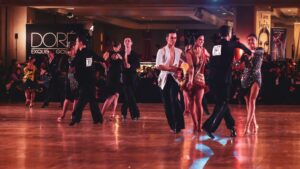Emotional Intelligence – Competency #5
 One of the realities of ballroom dancing is that you are always moving in close proximity to other people, especially your dance partner. If the dance floor is crowded, there will be people moving closer to you and moving away from you constantly, while you keep moving around them. There’s a lot going on.
One of the realities of ballroom dancing is that you are always moving in close proximity to other people, especially your dance partner. If the dance floor is crowded, there will be people moving closer to you and moving away from you constantly, while you keep moving around them. There’s a lot going on.
In other words, it’s quite possible to bump someone, or even take an elbow to the chin, for example, or experience an awkward collision of any number of random body parts. Not too surprisingly, newer dancers have the most issues with these challenges. After all they are spending their energy and attention on trying to get the steps right which makes it difficult to pay attention to everything going on around them. The skill dancers need to develop to manage all that is going on around them is called spatial awareness. “Spatial awareness is much more than just trying to avoid collisions. It’s an essential element in being able to apply floor craft, that ability to instantly move into a different step pattern than the one you initially planned, based entirely on the changing space around you.”* It’s about mental and physical flexibility.
For leaders, the comparable skill is self-awareness, a foundational component of emotional intelligence.
The study we’ve been exploring the past few weeks** lists emotional intelligence as the fifth competency needed by leaders. According to Wikipedia, the term was first used in 1964, but psychologist Daniel Goleman brought it to wider attention with his research and writing. Originally considered to have four elements, emotional intelligence now includes five elements, empathy, effective communication or social skills, self-awareness, self-regulation, and motivation. Further refinement has led to the idea that there are two ways to think about emotional intelligence – innate traits and ability to practice these different elements.
I imagine that everyone has experienced working with people at either end of a spectrum from people who are highly attuned to themselves and others to those who seem to be completely unaware of their own behavior and the effect of their actions on others. We also have worked with people who are effective in a variety of situations with multiple people and purposes.
In dancing, knowing the steps only gets you so far, but not having spatial awareness can leave you stepping on your partner’s toes or crashing into others on the dance floor. In the same way a lack of self-awareness can leave leaders floundering. Self-awareness is considered by many, including Goldman, to be the most important component of emotional intelligence.
What was interesting to me as I did a bit of exploration for this essay is that the work suggested to help people improve their self-awareness includes many activities suggested for self-care and developing healthy habits for our mental health. Activities like journaling, meditation, and yoga are activities that can help us be more in tune with ourselves and with others, No wonder it’s foundational to both emotional intelligence and to leadership.
Early in our dance life we need to practice steps. We develop spatial awareness as we become more experienced. The same can be true of our leadership life. Early on we focus on skills like delegation and supervision, but to truly become good leaders, we have to develop the skills of emotional intelligence and a great place to start is with self-awareness. As we do, we begin to see the other ways in which we will benefit from working on our emotional intelligence skills. I’ve included a couple of links to articles about self-awareness and the work we can do to learn how to move through our leadership work without stepping on others’ toes!
Take care,
Gage
*https://delta.dance/2020/03/spatial-awareness-dancers-secret-weapon/
